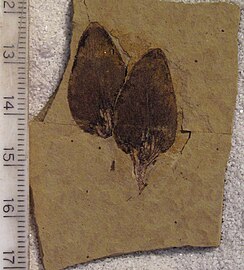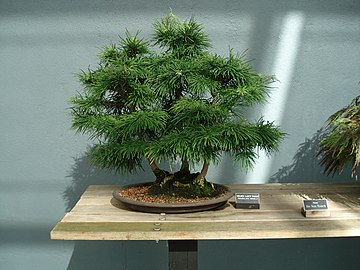Pseudolarix
| Pseudolarix Temporal range: Early Cretaceous to recent
| |
|---|---|

| |
| Scientific classification | |
| Kingdom: | Plantae |
| Clade: | Tracheophytes |
| Clade: | Gymnospermae |
| Division: | Pinophyta |
| Class: | Pinopsida |
| Order: | Pinales |
| Family: | Pinaceae |
| Subfamily: | Abietoideae |
| Genus: | Pseudolarix Gordon |
| Species | |
| |
| Synonyms | |
| |
Pseudolarix is a
Late Eocene Buchanan Lake Formation on Axel Heiberg Island.[1] P. japonica is known from Middle Miocene to Pliocene sediments in Japan and Miocene deposits of Korea.[2] Fossils assigned to Pseudolarix as a genus date possibly as old as the Early Cretaceous Hauterivian stage in Mongolia.[1]
Growth
It is a
coniferous tree reaching 30–40 m (98–131 ft) tall, with a broad conic crown. The shoots are dimorphic, with long shoots and short shoots similar to a larch, though the short shoots are not so markedly short, lengthening about 5 mm annually. The leaves
are bright green, 3–6 cm long and 2–3 mm broad, with two glaucous stomatal bands on the underside; they turn a brilliant golden yellow before falling in the autumn, hence the common name. The leaves are arranged spirally, widely spaced on long shoots, and in a dense whorl on the short shoots.
The
globe artichoke, 4–7 cm long and 4–6 cm broad, with pointed triangular scales; they mature about 7 months after pollination, when (like fir and cedar cones) they disintegrate to release the winged seeds
. The male cones, as in Keteleeria, are produced in umbels of several together in one bud.
Gallery
-
Ypresian aged Pseudolarix wehrii cone scale fossils
-
Full tree
-
Needles and mature cone in fall
-
Bonsai example
References
- ^ S2CID 84724593.
- .
External links
 Media related to Pseudolarix at Wikimedia Commons
Media related to Pseudolarix at Wikimedia Commons Data related to Pseudolarix at Wikispecies
Data related to Pseudolarix at Wikispecies




